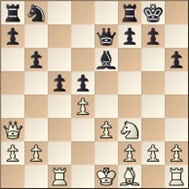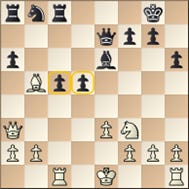Pawn structures may take many forms, and govern what we should and shouldn't do in a position. Pawn structure guide us towards a plan. General rules of thumb can be formed about each type of structure. In this article we discuss hanging pawn; the term describes a situation that occurs in many popular opening variations. Pawns stand on adjacent files, separated from other pawns, and can only be defended by pieces.
Hanging pawns :
1) Can control important central squares;
2) Can help to create an attack by advancing at the right moment;
3) Must be backed up with active pieces.
Hanging pawns can be disjointed and destroyed if these preconditions are not met.
Fischer, Robert James (2785) - Spassky, Boris V (2660)
World Championship 28th Reykjavik (6), 23.07.1972
We are going to take a look at two instructive games by Bobby Fischer. It will become obvious that he had a consummate understanding of this type of pawn structure. The first game is a masterpiece.
1.c4 e6 2.Nf3 d5 3.d4 Nf6 4.Nc3 Be7 5.Bg5 0–0 6.e3 h6 7.Bh4 b6
The Tartakower system is logical. In a potentially cramped situation, Black creates room for his queenside pieces to breathe. Eventually he hopes to play ...c7–c5,freeing his game.
8.cxd5 Nxd5 9.Bxe7 Qxe7 10.Nxd5 exd5 11.Rc1 Be6 12.Qa4 c5 13.Qa3!
By pinning and attacking the pawn on c5 White limits Black's potential for activity.
13...Rc8 14.Bb5 a6 It was discovered later that 14...Qb7!:
… was an effective counter, with the point that after 15.dxc5 (15.0–0 c4) Black has 15...bxc5 16.Rxc5 Rxc5 17.Qxc5 Na6! with excellent development, and forcing 18.Qc6 Qxc6 19.Bxc6 Rb8.
White has not scored very well from this position. Black has twin threats of ...Rxb2 and ...Nb4.
15.dxc5 bxc5
Here we have a classic pair of hanging pawns on d5 and c5. What Black doesn't want is to be tied down to defending these pawns the whole game through. He has to look for ways to get active, but this isn't possible for the time being. Spassky has to defend carefully.
16.0–0 Ra7 17.Be2 Nd7 18.Nd4! The great players note every detail in a position. Black's undefended pieces on e7 and c8 give Fischer the chance to land a tactical blow, leading to a positional grip.
18...Qf8 19.Nxe6 fxe6 20.e4!
A brilliant move, disjointing the hanging pawns. As the pawns are forced forward, they cover fewer squares.
20...d4 21.f4 Qe7 21...e5 22.fxe5 Qe7 23.Qb3+ Kh8 24.Rf7 Qxe5 25.Qd5! is awful for Black, who is tied down.
22.e5 Rb8 23.Bc4 A great square for the bishop! White is in control.
23...Kh8 24.Qh3 Nf8 Black is not completely lost, but he is totally tied down, and the central pawns are going nowhere. There is the distinct prospect of a white kingside attack.
25.b3 a5 26.f5 exf5 27.Rxf5 Nh7 27...a4 28.Rcf1 axb3 29.axb3 does not really help Black, who is still facing ideas such as Qg3 and Rf7.
28.Rcf1 Qd8 29.Qg3 Re7 30.h4!
Restricting the knight.
30...Rbb7 31.e6 Rbc7 32.Qe5 Qe8 33.a4 Qd8 34.R1f2 Qe8 35.R2f3 White takes his time. Black must hope that the idea of Bd3 and Qe4 will not force his resignation.
35...Qd8 36.Bd3 Qe8 37.Qe4 Nf6 38.Rxf6! An absolute crusher.
38...gxf6 39.Rxf6
39...Kg8 Nothing works: 39...c4 40.Rxh6+ Kg8 41.Bxc4 Rxc4 42.bxc4 d3 43.Qxd3; 39...Rg7 40.Rxh6+ Kg8 41.e7!; 39...h5 40.Qe5 Rg7 41.e7! Rcxe7 42.Rh6+ Kg8 43.Bc4+
40.Bc4 Kh8 41.Qf4 One of the finest games of a famous match. If you accept hanging pawns, you must have a clear vision of how you are going to dissolve or advance them, or how to avoid them becoming static and increasingly vulnerable to attack. 1–0
Bertok, Mario - Fischer, Robert James
Stockholm Interzonal Stockholm (22), 04.03.1962
Fischer had previous experience of hanging pawns, and this time we see the other side of the coin.
1.d4 d5 2.c4 e6 3.Nc3 Be7 4.Nf3 Nf6 5.Bg5 0–0 6.e3 h6 7.Bh4 b6 8.cxd5 Nxd5 9.Bxe7 Qxe7 10.Nxd5 exd5 11.Be2 Be6 12.0–0 c5 13.dxc5 bxc5 14.Qa4 Qb7!
White has settled for a modest set-up, and has not yet put any pressure on the black central pawns. This enables Fischer to deploy his pieces more actively than Spassky was able to do.
15.Qa3 Nd7 16.Ne1 a5! The idea is to fix the white pawn structure on the queenside. Somehow, without making an appreciable mistake, Bertok falls into a passive position. The active position of the black queen makes all the difference.
17.Nd3 c4! 18.Nf4 Rfb8 19.Rab1?!












